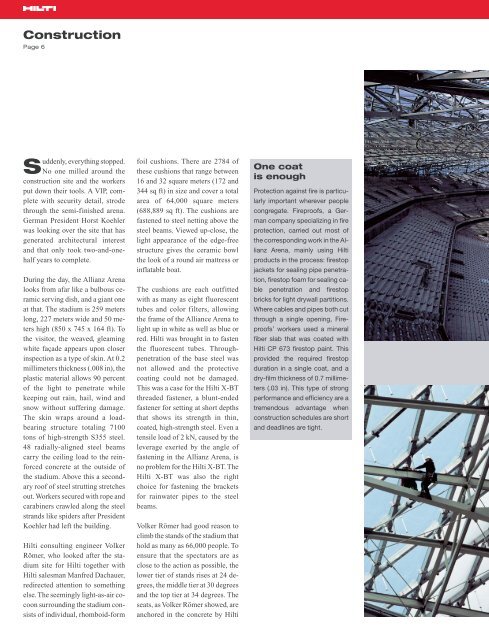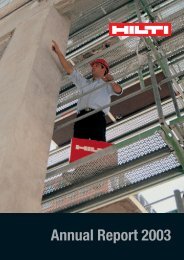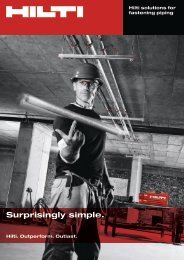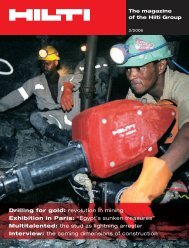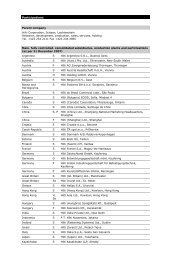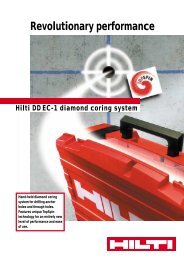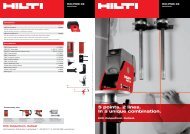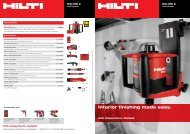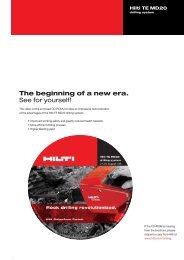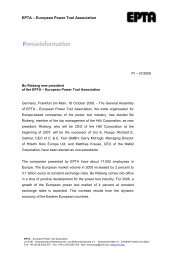Netherlands: high-tech fastening for high-speed track ... - Hilti
Netherlands: high-tech fastening for high-speed track ... - Hilti
Netherlands: high-tech fastening for high-speed track ... - Hilti
You also want an ePaper? Increase the reach of your titles
YUMPU automatically turns print PDFs into web optimized ePapers that Google loves.
Construction<br />
Page 6<br />
Suddenly, everything stopped.<br />
No one milled around the<br />
construction site and the workers<br />
put down their tools. A VIP, complete<br />
with security detail, strode<br />
through the semi-finished arena.<br />
German President Horst Koehler<br />
was looking over the site that has<br />
generated architectural interest<br />
and that only took two-and-onehalf<br />
years to complete.<br />
During the day, the Allianz Arena<br />
looks from afar like a bulbous ceramic<br />
serving dish, and a giant one<br />
at that. The stadium is 259 meters<br />
long, 227 meters wide and 50 meters<br />
<strong>high</strong> (850 x 745 x 164 ft). To<br />
the visitor, the weaved, gleaming<br />
white façade appears upon closer<br />
inspection as a type of skin. At 0.2<br />
millimeters thickness (.008 in), the<br />
plastic material allows 90 percent<br />
of the light to penetrate while<br />
keeping out rain, hail, wind and<br />
snow without suffering damage.<br />
The skin wraps around a loadbearing<br />
structure totaling 7100<br />
tons of <strong>high</strong>-strength S355 steel.<br />
48 radially-aligned steel beams<br />
carry the ceiling load to the rein<strong>for</strong>ced<br />
concrete at the outside of<br />
the stadium. Above this a secondary<br />
roof of steel strutting stretches<br />
out. Workers secured with rope and<br />
carabiners crawled along the steel<br />
strands like spiders after President<br />
Koehler had left the building.<br />
<strong>Hilti</strong> consulting engineer Volker<br />
Römer, who looked after the stadium<br />
site <strong>for</strong> <strong>Hilti</strong> together with<br />
<strong>Hilti</strong> salesman Manfred Dachauer,<br />
redirected attention to something<br />
else. The seemingly light-as-air cocoon<br />
surrounding the stadium consists<br />
of individual, rhomboid-<strong>for</strong>m<br />
foil cushions. There are 2784 of<br />
these cushions that range between<br />
16 and 32 square meters (172 and<br />
344 sq ft) in size and cover a total<br />
area of 64,000 square meters<br />
(688,889 sq ft). The cushions are<br />
fastened to steel netting above the<br />
steel beams. Viewed up-close, the<br />
light appearance of the edge-free<br />
structure gives the ceramic bowl<br />
the look of a round air mattress or<br />
inflatable boat.<br />
The cushions are each outfitted<br />
with as many as eight fluorescent<br />
tubes and color filters, allowing<br />
the frame of the Alliance Arena to<br />
light up in white as well as blue or<br />
red. <strong>Hilti</strong> was brought in to fasten<br />
the fluorescent tubes. Throughpenetration<br />
of the base steel was<br />
not allowed and the protective<br />
coating could not be damaged.<br />
This was a case <strong>for</strong> the <strong>Hilti</strong> X-BT<br />
threaded fastener, a blunt-ended<br />
fastener <strong>for</strong> setting at short depths<br />
that shows its strength in thin,<br />
coated, <strong>high</strong>-strength steel. Even a<br />
tensile load of 2 kN, caused by the<br />
leverage exerted by the angle of<br />
<strong>fastening</strong> in the Allianz Arena, is<br />
no problem <strong>for</strong> the <strong>Hilti</strong> X-BT. The<br />
<strong>Hilti</strong> X-BT was also the right<br />
choice <strong>for</strong> <strong>fastening</strong> the brackets<br />
<strong>for</strong> rainwater pipes to the steel<br />
beams.<br />
Volker Römer had good reason to<br />
climb the stands of the stadium that<br />
hold as many as 66,000 people. To<br />
ensure that the spectators are as<br />
close to the action as possible, the<br />
lower tier of stands rises at 24 degrees,<br />
the middle tier at 30 degrees<br />
and the top tier at 34 degrees. The<br />
seats, as Volker Römer showed, are<br />
anchored in the concrete by <strong>Hilti</strong><br />
One coat<br />
is enough<br />
Protection against fire is particularly<br />
important wherever people<br />
congregate. Fireproofs, a German<br />
company specializing in fire<br />
protection, carried out most of<br />
the corresponding work in the Allianz<br />
Arena, mainly using <strong>Hilti</strong><br />
products in the process: firestop<br />
jackets <strong>for</strong> sealing pipe penetration,<br />
firestop foam <strong>for</strong> sealing cable<br />
penetration and firestop<br />
bricks <strong>for</strong> light drywall partitions.<br />
Where cables and pipes both cut<br />
through a single opening, Fireproofs’<br />
workers used a mineral<br />
fiber slab that was coated with<br />
<strong>Hilti</strong> CP 673 firestop paint. This<br />
provided the required firestop<br />
duration in a single coat, and a<br />
dry-film thickness of 0.7 millimeters<br />
(.03 in). This type of strong<br />
per<strong>for</strong>mance and efficiency are a<br />
tremendous advantage when<br />
construction schedules are short<br />
and deadlines are tight.


